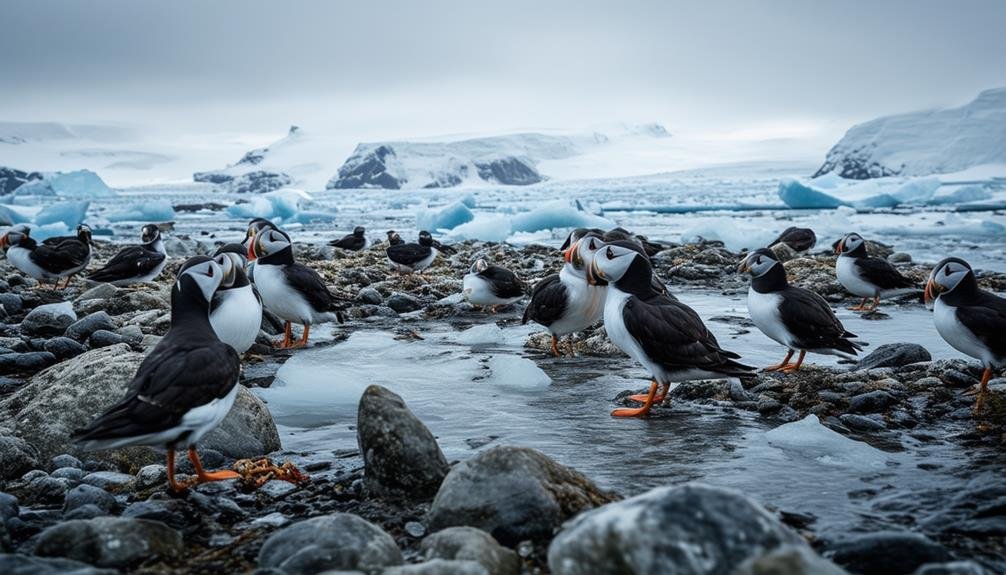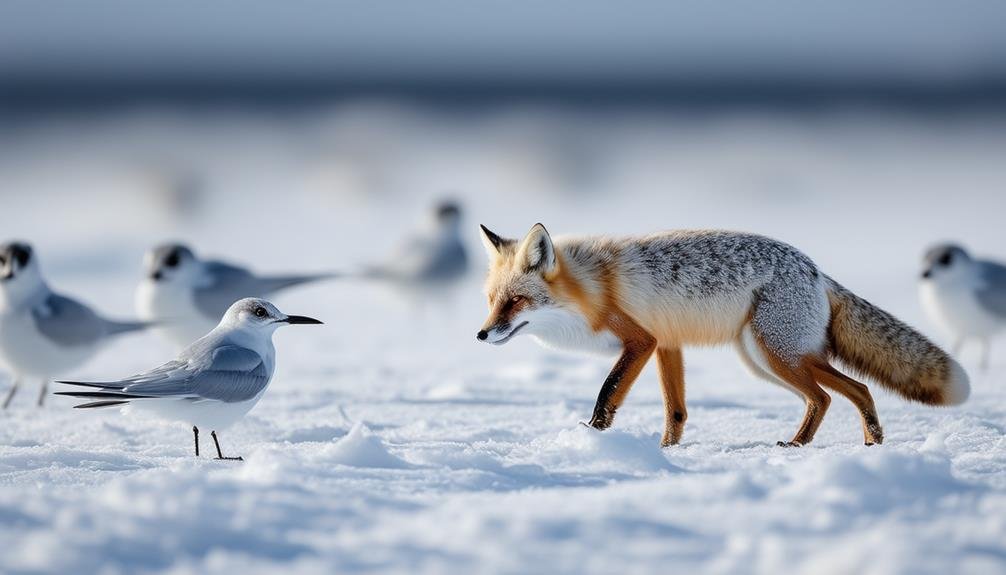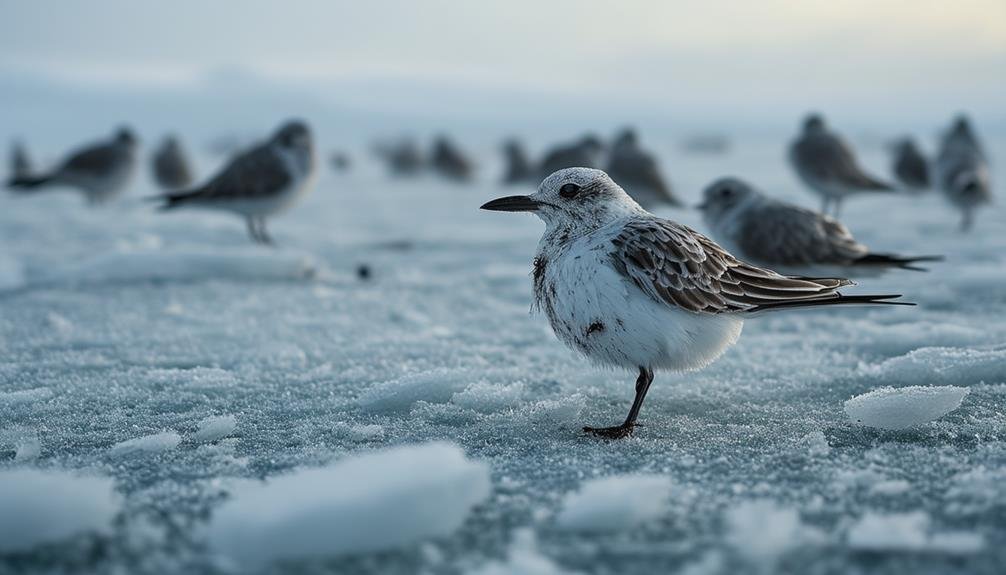You're facing a complex situation with Arctic bird species as they struggle with multiple threats to their survival. Key issues include climate change, which disrupts their habitats and breeding times, and shrinking ice fields that alter essential migration patterns. Invasive species pose a competitive threat for scarce resources, while pollution and contaminants damage their nesting sites. Overfishing reduces their food supplies, and increased predation, especially from expanding red fox populations, adds further strain. Human activities such as tourism and industrial development disrupt their environments, and diseases spread more quickly among them. Addressing these challenges is crucial. More insights await as you explore these interconnected issues further.
Main Points
- Climate change leads to habitat loss and disrupted breeding for Arctic birds.
- Invasive species compete with native birds, reducing their populations.
- Pollution and contaminants damage bird habitats and health.
- Overfishing depletes crucial food sources for Arctic birds.
- Increased human activities disrupt breeding and feeding behaviors.
Climate Change Impact
As climate change progresses, it dramatically alters the habitats essential for the survival of Arctic bird species. The warming temperatures trigger habitat loss at alarming rates, directly impacting these birds' ability to thrive. You mightn't see it day-to-day, but the gradual disappearance of traditional nesting grounds forces many species to either adapt quickly or face severe population declines.
The decrease in snow cover, another consequence of rising global temperatures, significantly reduces the availability of food for Arctic birds. Normally, these birds rely on a delicate balance of seasonal changes that dictate food availability and breeding times. However, as you're observing, climate change disrupts these natural cycles. Earlier springs lead to earlier insect hatches, which might sound trivial, but it's a significant mismatch for bird species that aren't ready to feed their young at these altered times.
Recognizing these challenges, conservation initiatives are more vital than ever. They aim to mitigate the effects of climate change on these vulnerable bird species by protecting critical habitats and researching adaptive strategies. These efforts support the resilience of Arctic bird populations, ensuring they continue to grace the skies despite the environmental adversities they face. Your awareness and support can contribute to these critical conservation successes.
Shrinking Ice Habitats
Shrinking ice habitats critically endanger the survival of iconic Arctic birds like the Snowy Owl and Ivory Gull. As the Arctic tundra undergoes dramatic changes, these species face unprecedented habitat loss. You're witnessing a stark transformation in a region once defined by its expansive ice fields. These changes directly impact the birds that depend on this frozen landscape for breeding, feeding, and resting.
Climate changes are accelerating the decline of sea ice, disrupting not just the landscape but also the essential food chains that sustain various species of birds. For instance, the Arctic Tern and Long-tailed Duck are struggling as their ice-dependent habitats shrink. This loss of habitat poses a severe threat to their survival, pushing them towards endangerment.
As the ice recedes, the challenges mount for these birds. Their migration patterns, honed over millennia, are now leading them to environments that are increasingly inhospitable. The future of these birds is tied closely to their icy homes, and as you see these habitats diminish, so too does the hope for these species' continued existence. Without significant efforts to mitigate these effects, the legacy of the Arctic's avian population hangs in the balance.
Invasive Species Threats
Why are invasive species such a dire threat to Arctic bird populations? These unwelcome invaders, including rats, cats, and foxes, have been introduced to Arctic regions where they pose a significant risk. By competing for resources and disrupting ecosystems, invasive species jeopardize the survival of native Arctic bird species. Predation by these invaders is particularly devastating, leading to population declines and even the potential extinction of vulnerable bird species.
Control measures and eradication efforts are essential in combating this threat. You must understand that without these actions, the balance of the Arctic ecosystem could be irreversibly damaged. Collaborative efforts to address and mitigate the impacts of invasive species are crucial. These include setting traps, poisoning, and habitat management to limit the spread and impact of these predators.
It's important to support and participate in these initiatives to safeguard the survival of Arctic bird species. The eradication of invasive species not only helps in stabilizing bird populations but also restores the natural balance of the ecosystem, ensuring the health and sustainability of these unique environments for future generations. Remember, every species plays a role in the ecological tapestry, and the loss of one can unravel the entire system.
Pollution and Contaminants
Arctic birds' survival is severely jeopardized by pollution and contaminants that invade their habitats. You're facing a crisis where oil spills, industrial pollutants, and other toxic substances are increasingly affecting the environments that these birds rely on. These contaminants not only harm the birds directly but also damage their nesting sites and foraging grounds, which are critical for their survival.
The impact doesn't stop there. Pollution leads to bioaccumulation in Arctic ecosystems, a process where toxic substances build up in organisms over time. This is particularly dangerous for Arctic bird species at higher trophic levels, as they end up ingesting higher concentrations of these toxins. This bioaccumulation can lead to severe health issues and decreases in bird populations, threatening the overall biodiversity of the region.
Addressing this issue is important. Without intervention, the contamination of Arctic habitats could lead to devastating effects on bird species that are already struggling to cope with other environmental stresses. It's necessary to reduce pollution sources and clean up existing contaminants to protect these vulnerable bird populations and safeguard their habitats remain safe and healthy. Your awareness and action can help make a difference in preserving these crucial species.
Overfishing Effects

While pollution poses a serious threat, overfishing also greatly undermines the survival of Arctic bird species by depleting their primary food sources. As you explore the harsh realities faced by Arctic seabirds, it's clear that their sustenance is being jeopardized. Overfishing disrupts marine ecosystems, creating a ripple effect that starves these birds of the nourishment they depend on.
The decline in fish populations isn't just a statistic; it translates directly into food scarcity for these birds. They're finding it increasingly difficult to feed themselves and their young, leading to a potential decline in their populations. Additionally, the competition for the dwindling fish resources intensifies, adding another layer of challenge for survival. The diminished prey base is a critical issue; without sufficient food, the reproductive success and long-term viability of seabird species are at risk.
This is where sustainable fisheries management becomes essential. Implementing practices that prevent overfishing is vital for the health of Arctic marine ecosystems and, by extension, the seabirds that inhabit them. You must recognize the interconnected nature of these issues; sustainable management isn't just beneficial, it's necessary for the survival of these unique Arctic inhabitants.
Oil and Gas Development
Oil and gas development greatly disrupts the habitats of Arctic birds, leading to increased pollution and habitat destruction. As you're considering the impact of these activities, it's important to recognize how they directly affect the survival of various bird species native to the Arctic.
Here are some key points:
- Habitat Destruction: Industrial activities clear vast areas, removing critical nesting and feeding grounds that species like the Ivory Gull depend on.
- Oil Spills: These incidents coat the feathers of birds, reducing their insulation and buoyancy, which can lead to hypothermia and drowning. Oil also poisons the water and food sources birds rely on.
- Contamination: Beyond visible oil spills, the long-term contamination from drilling activities disrupts the food chain, affecting the health and reproductive success of bird populations.
- Conservation Efforts: It's important that conservation efforts intensify to regulate and monitor oil and gas operations, ensuring that the delicate balance of Arctic habitats isn't tipped further towards decline.
Understanding the full scope of these disturbances helps you appreciate why protecting these birds isn't just about saving species—it's about preserving the ecological integrity of the Arctic itself.
Increased Predation Risks

Facing increased predation risks, many Arctic bird species are experiencing significant threats to their survival. As you've observed, predators like red foxes, once confined to less frigid environments, are encroaching on territories traditionally occupied by Arctic birds. This shift, largely driven by climate change, is altering the delicate balance of the Arctic ecosystem.
As climate change progresses, the reduction in sea ice cover is particularly important. It's not just about the ice; it's about the accessibility it provides. Previously isolated bird nesting areas are becoming more reachable for predators, putting the breeding success of these birds at risk. You're seeing a direct impact on the population dynamics of these species, with predation pressure increasing as their traditional habitats become less secure.
In response to these challenges, conservation efforts are intensifying. These initiatives are vital in addressing the rising predation risks faced by Arctic bird species. By understanding and mitigating the factors that contribute to these changes, such as habitat alteration and the encroachment of new predators, conservationists are working to safeguard the survival of these species. It's a tough battle, but one that's essential for maintaining the biodiversity of the Arctic.
Disturbance From Human Activities
In addition to essential predators, human activities such as industrial development, tourism, and shipping also greatly disturb Arctic bird species. These disturbances can have a significant impact on the survival and behavior of various bird species in the Arctic. Let's dive deeper into how these activities are affecting the Arctic avian population:
- Disruption of Breeding Patterns: Industrial noise and physical presence of humans can lead to significant disruptions in the breeding habits of birds. This often results in lower reproduction rates.
- Interference with Feeding: Increased boat traffic and land use for tourism or industrial purposes can scare away the natural prey of birds, making feeding difficult.
- Alteration of Migration Routes: The presence of ships and other large vehicles can force birds to alter their traditional migration paths, which may lead to increased energy expenditure or even mortality.
- Habitat Destruction: Construction and expanded human footprint can destroy critical nesting sites and reduce the overall area where birds can live safely.
To safeguard these crucial bird populations, robust conservation efforts are needed to mitigate the negative impacts of human activities on Arctic bird species. By understanding and limiting these disturbances, you can contribute to preserving the delicate balance of Arctic ecosystems.
Disease and Parasites

Disease and parasites critically threaten the survival of Arctic bird species. You've probably heard of avian influenza, a severe disease that's wreaking havoc on bird populations worldwide, including those in the Arctic. In these regions, the impact can be particularly devastating. Due to the close proximity and communal nesting habits of Arctic bird species, diseases like avian influenza can spread rapidly, decimating entire colonies.
Moreover, parasites, such as ticks and mites, pose their own unique threats. These tiny invaders weaken birds, making them more susceptible to disease and less capable of dealing with other stressors. As you can imagine, a weakened bird is less likely to survive in the harsh Arctic environment.
That's why monitoring and addressing these outbreaks are so vital. By keeping an eye on the health of these bird populations, conservationists can act swiftly to mitigate the spread of disease and control parasite infestations. This monitoring helps protect the birds not only from immediate threats but also preserves their populations for future generations.
Global Warming and Weather Extremes
While disease and parasites are formidable challenges, the effects of global warming and extreme weather pose an even greater threat to the survival of Arctic bird species. You're witnessing a dramatic transformation in their world, primarily driven by the rapidly changing climate.
Here's how these changes are affecting them:
- Habitat Loss: As the Arctic warms, traditional nesting grounds are disappearing. This not only leaves bird species without a home but also disrupts their breeding cycles.
- Food Scarcity: The melting sea ice is reducing the availability of key food sources for Arctic birds. This can lead to nutritional deficiencies, impacting their health and reproductive success.
- Altered Migration Patterns: Rising temperatures are reshaping migration routes. Birds that once traveled predictable paths are now forced to adapt to new routes, which may not provide the same resources or safety.
- Extreme Weather Events: More frequent and severe storms are devastating for these birds. Unpredictable weather patterns make it difficult for them to find shelter and food, increasing mortality rates.
As you consider the plight of these Arctic bird species, it's clear that climate change isn't just altering their immediate environment—it's challenging their very survival.
Frequently Asked Questions
What Are the Threats to Endangered Birds?
You're facing several threats to endangered birds, including habitat destruction due to urban expansion and rising sea levels. Climate change disrupts their migration patterns, while pollution effects and illegal hunting further jeopardize their survival.
Additionally, invasive species can outcompete native birds for resources. Addressing these issues through global cooperation and stringent conservation measures is essential to protect these vulnerable species from further decline.
Which Is the Most Important Factor in the Threat of Extinction for Some Birds?
For some birds, habitat destruction stands as the most critical factor in their potential extinction. Influenced by climate change, which exacerbates habitat loss, it combines with other significant dangers like pollution impact, illegal trade, and invasive species.
Addressing these issues is essential. You'd find that conservation efforts focus on mitigating these threats to guarantee the survival and health of these vulnerable bird populations in their natural environments.
How Do Birds Survive in the Arctic?
As the saying goes, 'necessity is the mother of invention,' and Arctic birds are a demonstration of this.
You'll find that these birds utilize thick feather insulation and substantial fat reserves to combat the cold. Their migratory patterns are precisely timed to exploit abundant summer food resources, and their nesting habits are adapted to maximize warmth.
In addition, they make the most of the prolonged daylight, foraging extensively to sustain themselves in such a harsh environment.
What Are the Major Threats to the World's Bird Populations and Give Two Reasons for Protecting Bird Species From Extinction?
You're facing major threats to the world's bird populations, including habitat destruction, climate change, invasive species, pollution effects, and illegal hunting.
It's crucial to protect these species because they maintain ecosystem balance and support biodiversity. Birds help in seed dispersal, insect control, and pollination, which benefits both natural environments and human societies.
Loss of bird species can disrupt food chains and lead to ecological imbalances.
How Do Extreme Cold Conditions Contribute to the Threats Endangering Arctic Bird Species?
Extreme cold conditions can limit food availability, disrupt breeding patterns, and damage habitats, all of which pose significant threats to the survival of arctic birds in cold environments. Such challenges can reduce their population, making survival more difficult as they adapt to the rapidly changing climate in the Arctic.
Conclusion
As the old saying goes, 'a stitch in time saves nine.'
You're now aware of the ten critical threats facing arctic bird species.
It's imperative to act swiftly to mitigate these risks.
From combating climate change to regulating fishing practices, each step you support makes a difference.
By addressing these challenges, we help preserve not only the arctic avian population but also the ecological balance they help maintain.
Let's commit to making informed choices for their survival.


